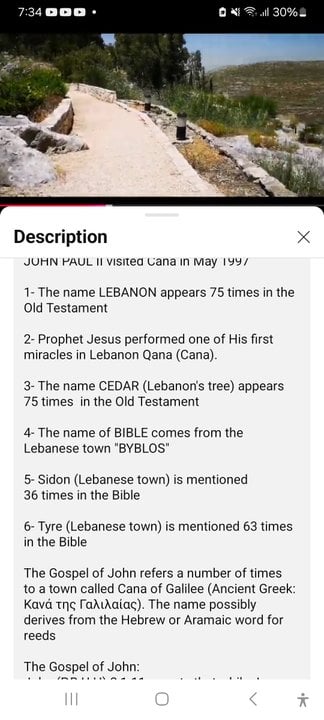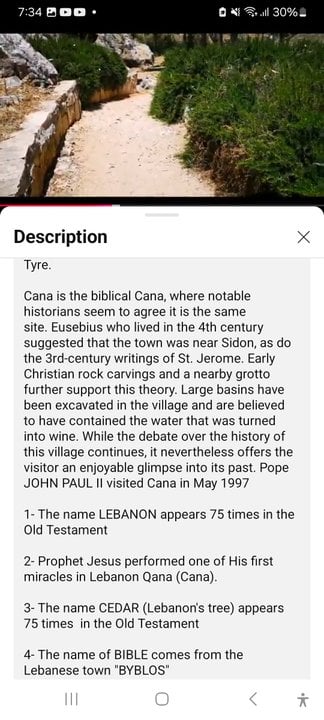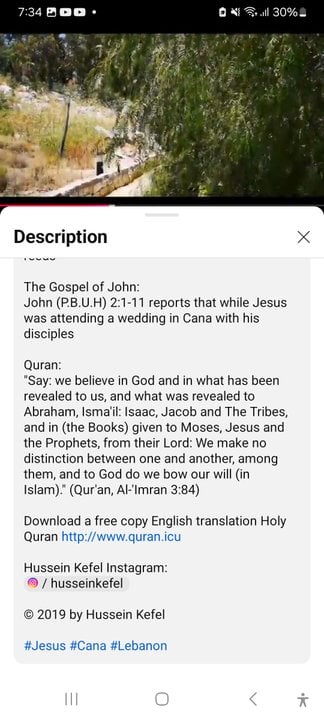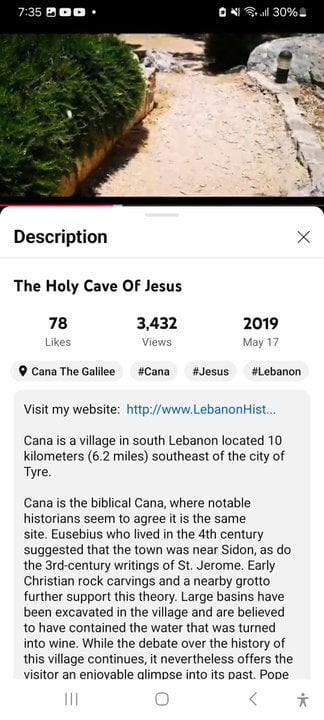This page is a permanent link to the reply below and its nested replies. See all post replies »
Northwest · M
Dollars to Donuts, you've never been to Hardeen, and you have no clue where Jesus lived, and where he visited.
There is no "Biblical" proof the historical figure known as Jesus was ever to Lebanon. For him, at the time, a trip to Hardeen would be equivalent to a trip to Mars now.
Those caves, and many others like them, hundreds of years later, protected Lebanon from Muslim invaders.
There is no "Biblical" proof the historical figure known as Jesus was ever to Lebanon. For him, at the time, a trip to Hardeen would be equivalent to a trip to Mars now.
Those caves, and many others like them, hundreds of years later, protected Lebanon from Muslim invaders.
1-25 of 37
Yassmeene · F
@Northwest Are you serious Lol😂😂😂
We as Lebanese or Levantine Arabs are very close and connected to the Christians/Jews in the area...Maybe you need to check out the "Holy Mount of Lebanon" which is mentioned by Christian historians to have been the place Jesus used to visit and ponder nature from...
Lebanon is the place of Jesus and it's the Place he loved visiting.
Also check out Jordan's historical Jewish sites,Oldest Jewish churches, temples and Christians scripts that the Ottomans preserved....
The Muslims of the Levantine never destroyed Christian/Jewish churches or historical scripts or landscapes...Our land entirely is the Land of Moses,Jesus and Muhammad.
We're the People and Land of The Prophets mentioned in the Bible,Gospel,Torah,Talmud,and Qouraan.
We as Lebanese or Levantine Arabs are very close and connected to the Christians/Jews in the area...Maybe you need to check out the "Holy Mount of Lebanon" which is mentioned by Christian historians to have been the place Jesus used to visit and ponder nature from...
Lebanon is the place of Jesus and it's the Place he loved visiting.
Also check out Jordan's historical Jewish sites,Oldest Jewish churches, temples and Christians scripts that the Ottomans preserved....
The Muslims of the Levantine never destroyed Christian/Jewish churches or historical scripts or landscapes...Our land entirely is the Land of Moses,Jesus and Muhammad.
We're the People and Land of The Prophets mentioned in the Bible,Gospel,Torah,Talmud,and Qouraan.
Yassmeene · F
@Northwest Really? Why does it bother you so much to know Jesus had connection to Lebanon?
The fact that you hate this shows us who the real enemies of Christianity are...
We the Muslims love Jesus...But I believe you hate this information because it shows/proves that The Land entirely was Connected, and it also shows that there was not states but it all was one land and one Nation, until your so-called peaceful Crusaders invaded the land,divided and seperated Lebanon which was a mountain from The Holy Land(Palestine).
The fact that you hate this shows us who the real enemies of Christianity are...
We the Muslims love Jesus...But I believe you hate this information because it shows/proves that The Land entirely was Connected, and it also shows that there was not states but it all was one land and one Nation, until your so-called peaceful Crusaders invaded the land,divided and seperated Lebanon which was a mountain from The Holy Land(Palestine).
Northwest · M
@Yassmeene
Lebanon is not mentioned in the New Testament, but a couple of cities are (Tyre and Sidon) and Mount Hermon. It is mentioned in the Old Testament 71 times.
So what?
No mention of the cave in the New Testament, however, there's something about a Canaanite woman who was possessed by the devil. Which may explain a few things. But so what?
How does that related to what I asked. Once more, you're plowing through with your speeches, not addressing any of the rebuttals presented to you.
Lebanon is mentioned in the Bible,The Holy mountain of Lebanon too...
Lebanon is not mentioned in the New Testament, but a couple of cities are (Tyre and Sidon) and Mount Hermon. It is mentioned in the Old Testament 71 times.
So what?
The Holy Cave of Jesus is licated in South Lebanon in the Phonecian city (Tyre).
No mention of the cave in the New Testament, however, there's something about a Canaanite woman who was possessed by the devil. Which may explain a few things. But so what?
How does that related to what I asked. Once more, you're plowing through with your speeches, not addressing any of the rebuttals presented to you.
This comment is hidden.
Show Comment
Yassmeene · F
You're so full of Hate,Jealousy,and Grudge that you can't accept the truth!!!
Lebanon is mentioned in the Bible, primarily in the Old Testament, around 70 times. The name "Lebanon" refers to a specific mountain range and its associated forests, particularly famous for its cedar trees.
Here's a more detailed look:
Mountain Range:
The Bible frequently uses "Lebanon" to refer to the mountain range, particularly the one known for its cedar trees.
Symbolic Meaning:
Lebanon was a source of valuable resources, particularly cedar wood, used in construction projects like King Solomon's Temple.
Geographical Boundaries:
Lebanon is also mentioned as part of the boundaries of the promised land for the Israelites.
Eschatological Texts:
The name Lebanon appears in eschatological texts, referring to the place where the Lord will show His presence.
Old Testament References:
You can find references to Lebanon in books like Deuteronomy, Joshua, Judges, Isaiah, and Psalms.
Not a State:
Importantly, the "Lebanon" in the Bible refers to a geographical feature (a mountain) and not a modern state, as the modern country of Lebanon.
Lebanon is mentioned in the Bible, primarily in the Old Testament, around 70 times. The name "Lebanon" refers to a specific mountain range and its associated forests, particularly famous for its cedar trees.
Here's a more detailed look:
Mountain Range:
The Bible frequently uses "Lebanon" to refer to the mountain range, particularly the one known for its cedar trees.
Symbolic Meaning:
Lebanon was a source of valuable resources, particularly cedar wood, used in construction projects like King Solomon's Temple.
Geographical Boundaries:
Lebanon is also mentioned as part of the boundaries of the promised land for the Israelites.
Eschatological Texts:
The name Lebanon appears in eschatological texts, referring to the place where the Lord will show His presence.
Old Testament References:
You can find references to Lebanon in books like Deuteronomy, Joshua, Judges, Isaiah, and Psalms.
Not a State:
Importantly, the "Lebanon" in the Bible refers to a geographical feature (a mountain) and not a modern state, as the modern country of Lebanon.
Yassmeene · F
@Northwest Home to famed forests and a beautiful mountain range, Lebanon was a source of valuable lumber for the Israelites. The cedar tree of Lebanon, which is featured on the modern flag of Lebanon, was prized because of its high-quality, fragrant timber. Solomon used cedar trees from Lebanon in the construction of the temple, as well as in the building of his palace, which was called “the Palace of the Forest of Lebanon” (1 Kings 5:5–6; 7:1–3). To collect the massive amount of lumber needed for the temple and palace, 30,000 Israelite men were conscripted and sent to Lebanon for one month at a time (1 Kings 5:13–14). Hiram, king of Tyre, had his workers cut the trees, haul the logs to the sea, and float them to a place where Solomon’s men could collect them (1 Kings 5:8–9
Yassmeene · F
@Northwest Jesus not only visited Lebanon and stepped on its soil , but he also performed his first miracle in Kana in the south of Lebanon during a wedding .
Jesus and his mother Mary both visited Lebanon and walked in cities that still exist and alive:
Maghdoucheh : where Mary waited while Jesus visited the Lebanese villages .
Sidon and Tyr : cities that Jesus and his disciples visited and met the inhabitants ( Phoenicians at that time ). And he healed the Canaanite woman's daughter between Tyr and Sidon.
Jesus and his mother Mary both visited Lebanon and walked in cities that still exist and alive:
Maghdoucheh : where Mary waited while Jesus visited the Lebanese villages .
Sidon and Tyr : cities that Jesus and his disciples visited and met the inhabitants ( Phoenicians at that time ). And he healed the Canaanite woman's daughter between Tyr and Sidon.
Yassmeene · F
@Northwest Lebanon’s Christian heritage can be traced back to the Old Testament. The famed Cedars of Lebanon are referred to numerous times in the Bible as symbols of beauty and strength. Moreover, Lebanese cedar wood was sent to Jerusalem for the construction of Solomon’s Temple. Jesus and his disciples preached in the cities of Sour (Tyre) and Saida (Sidon), and Christianity was brought to Lebanon by the apostle St. Peter. Lebanon is mentioned over 70 times in the Bible, and there are ancient Christian sites of interest scattered throughout the country. For example, the village of Qana, where it is believed Jesus performed the miracle of turning water into wine, is located in South Lebanon. In addition to the many Biblical sites in the South, the Qadisha Valley (”Holy Valley”), the seat of the Maronite Church, offers a wealth of hidden, rock-cut monasteries, grottoes, and sacred sites waiting to be explored. Visit the ancient ruins of Sour (Tyre), Baalbek, or other sites to discover traces of Lebanon’s Byzantine/Orthodox heritage.
If you trace the map of all these places, then yes Jesus did Walk through the Cedars of God.
If you trace the map of all these places, then yes Jesus did Walk through the Cedars of God.
Northwest · M
@Yassmeene
Yet, you actually said:
Really, because your Holy book, accepts Christians as people of the "Book", and Mary as the Virgin Mother of Jesus, "Sourat Mariam".
There is no real evidence the historical figure known as Jesus ever really existed, much less visited Lebanon. The passages in the Bible refer to an area bordering Judea.
No to mention the impossibility of him visiting Hardeen, given that these caves were constructed POST Islamic invasion.
I said "Old testament"!!!
Yet, you actually said:
Lebanon is mentioned in the Bible
We don't accept the new testament as Muslims.
Really, because your Holy book, accepts Christians as people of the "Book", and Mary as the Virgin Mother of Jesus, "Sourat Mariam".
Jesus not only visited Lebanon and stepped on its soil , but he also performed his first miracle in Kana in the south of Lebanon during a wedding .
There is no real evidence the historical figure known as Jesus ever really existed, much less visited Lebanon. The passages in the Bible refer to an area bordering Judea.
No to mention the impossibility of him visiting Hardeen, given that these caves were constructed POST Islamic invasion.
This comment is hidden.
Show Comment
Yassmeene · F
@Northwest Your stubbornness and hate will prevent you from seeing the truth!!
The statement refers to the Sykes-Picot Agreement reached in 1916, where Britain and France divided the Ottoman Empire's Arab territories into British and French spheres of influence. This agreement, and the subsequent mandates system, carved out the modern boundaries of countries like Syria, Lebanon, Palestine, Iraq and Transjordan, which was later named Jordan
The statement refers to the Sykes-Picot Agreement reached in 1916, where Britain and France divided the Ottoman Empire's Arab territories into British and French spheres of influence. This agreement, and the subsequent mandates system, carved out the modern boundaries of countries like Syria, Lebanon, Palestine, Iraq and Transjordan, which was later named Jordan
Yassmeene · F
@Northwest In Islamic usage, "Al-Sham" (also written as Sham or Shem) refers to the Greater Syria region, also known as the Levant, which encompasses modern-day countries like Syria, Lebanon, Palestine, Jordan, and Iraq as well as parts of Turkey.
It's a historically significant area in Islam, with the Prophet Muhammad having spoken highly of it.The term "Bilad al-Sham" specifically refers to the Caliphate province of the same region.
It's a historically significant area in Islam, with the Prophet Muhammad having spoken highly of it.The term "Bilad al-Sham" specifically refers to the Caliphate province of the same region.
Yassmeene · F
@Northwest The Prophet Muhammad{PBUH}spoke highly of Bilad Al-Sham,emphasizing its special place in Islam and encouraging believers to protect it's people and honour it.
Almost no other region has as many virtues mentioned by the Prophe{PBUH}about it as this region,which comprises Palestine, Syria,Lebanon,Jordan and,parts of Iraq.
It is a land of Prophets,miracles,the defeat of oppressors,and the gathering on the Day of Judgment.
Almost no other region has as many virtues mentioned by the Prophe{PBUH}about it as this region,which comprises Palestine, Syria,Lebanon,Jordan and,parts of Iraq.
It is a land of Prophets,miracles,the defeat of oppressors,and the gathering on the Day of Judgment.
This comment is hidden.
Show Comment
1-25 of 37






